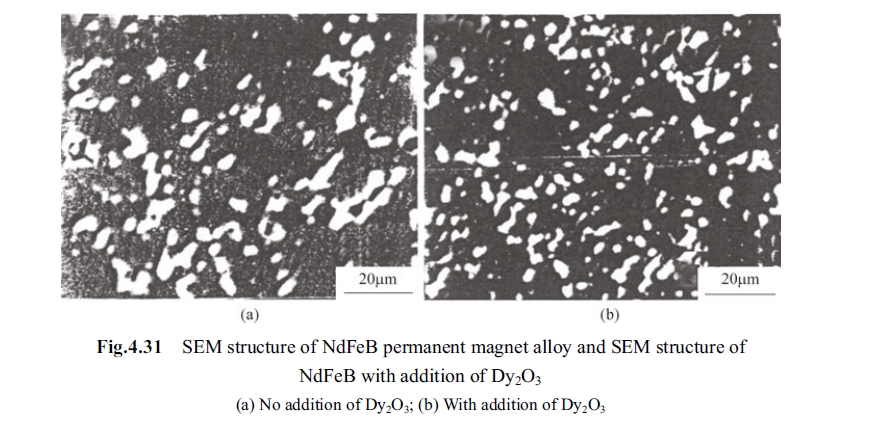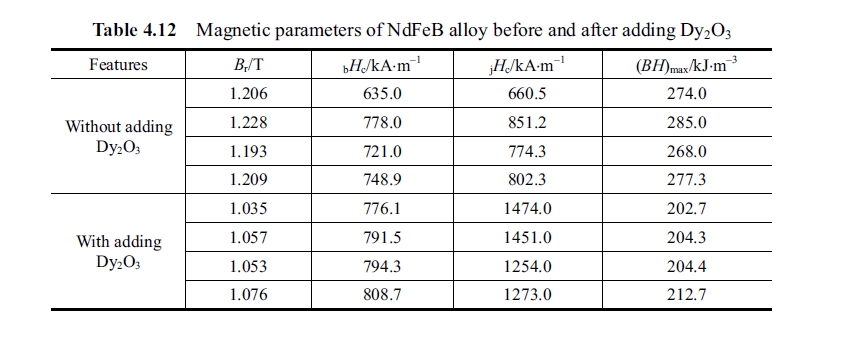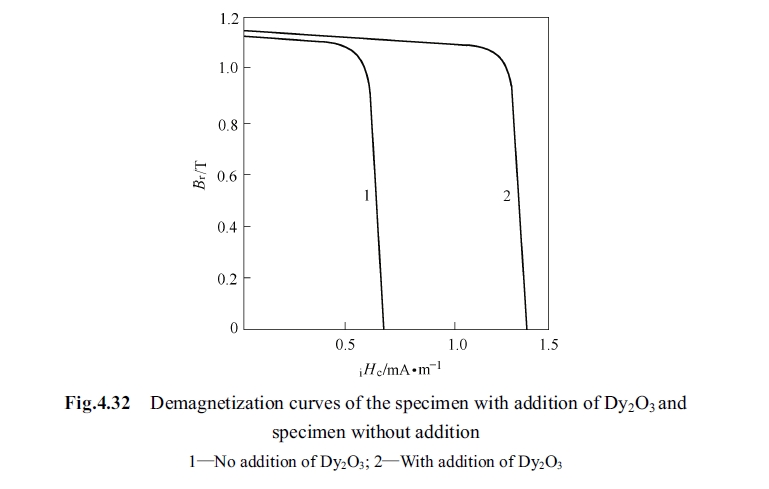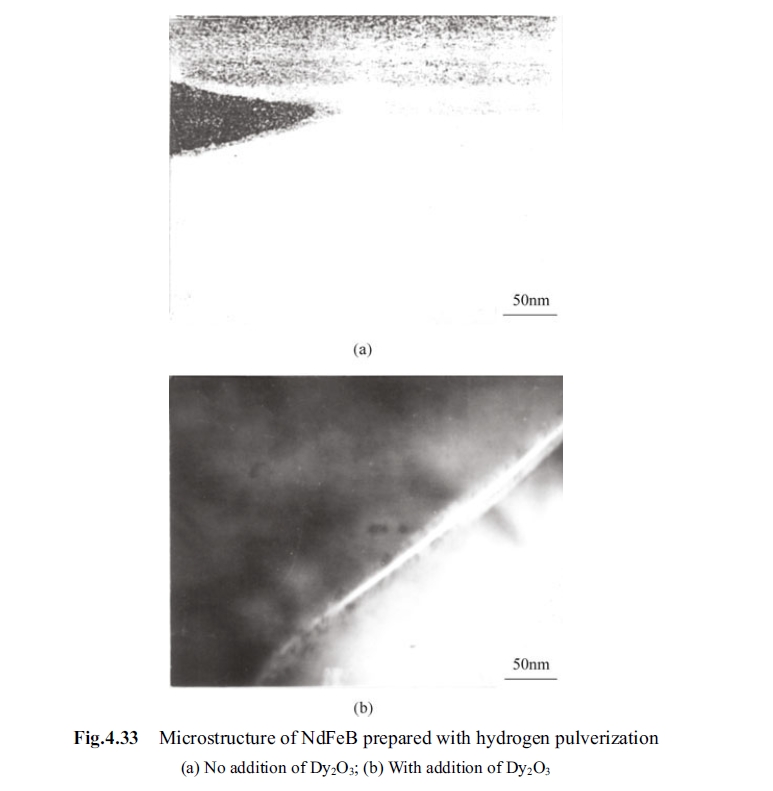4.7 Influence of Adding Element Dysprosium on the Performance of NdFeB Alloy
On sintering of performance of NdFeB permanent magnetic alloy the biggest influence is oxygen content and the milling process is a key procedure causing high oxygen content in the alloy. After hydrogenated and crushed, the powder is pulverized to 3 - 4 μm is an effective method to reduce oxygen content in alloy (Pan, Ma, Ping, et al, 1991; Zhou, 1990).
It was found in study that the powder was hydrogenated and crushed to confect NdFeB permanent magnetic alloy where the crystal granule was abnormally big. The abnormal big size of the granule may reach 400 nm in magnet sintered at 1000°C for 1.5 h. The formation of abnormal big granule will lower magnetic performance of the alloy. This abnormal big granule is very harmful for magnetism, especially for coercivity of the alloy, which made the intrinsic coercivity largely degrade.
However, hydrogenated milling is a good method for milling of NdFeB permanent magnetic alloy because it can make oxidized content be lowered to the minimum limit. If a good method can be found that the intrinsic coercivity will not be degraded, i.e., to prevent the granule from growing big, then the purpose can be reached that oxygen content can be lowered and the intrinsic coercivity does not be degraded. This section is to study this problem.
Specimen Preparation and Experimental Methods for Dysprosium-Enhanced NdFeB Alloys
The alloy was melted in a middle frequency induction furnace with 99.5% pure metallic neodymium, iron and B - Fe alloy containing 18.4% of boron; the alloy ingot was hydrogenated and crushed, and then was pulverized into powder in ball milling. The powder with the granule size of 3 - 4 μm was orientation molding pressed under magnetic field over 1.5 T and the molding pressure was bigger than 2 T/cm². The molded billet was sintered in vacuum at 1100°C for 100 min. For contrast \(Dy_{2}O_{3}\) was added into hydrogenated coarse powder which was then pulverized in ball miller. After sintered at high temperature the billet was put the magnet for aging at 500 - 600°C and its magnetism was measured using loop instrument of closed magnetic route.
SEM Analysis of NdFeB Alloys with Dysprosium Additions
Two types of samples with and without adding \(Dy_{2}O_{3}\) after hydrogenated milling were observed by using SEM. The micro texture of permanent magnetic alloy without \(Dy_{2}O_{3}\) is shown in Fig. 4.31(a) and the micro texture with \(Dy_{2}O_{3}\) is shown in Fig. 4.31(b). It can be seen from Fig. 4.31 that the permanent magnetic alloy with adding \(Dy_{2}O_{3}\) has comparative smaller crystal granule.

Magnetic Property Measurements of Dy-Doped NdFeB Alloys
The intrinsic coercivity \(_{i}H_{c}\) of the permanent magnetic alloy after adding \(Dy_{2}O_{3}\) was enhanced to 1474 kA/m from the original 660.5 kA/m. The data of \(B_{r}\), \(_{b}H_{c}\) and \((BH)_{max}\) are shown in Table 4.12. It can be seen from comparison of 4 groups data in the table that after addition of \(Dy_{2}O_{3}\) the \(_{i}H_{c}\) was enhanced from 660.5 kA/m, 851.2 kA/m, 774.3 kA/m and 802.3 kA/m to 1,474.0 kA/m, 1,451.0 kA/m, 1,254.0 kA/m and 1,273.0 kA/m respectively; \(_{b}H_{c}\) was enhanced from 635.0 kA/m, 778.0 kA/m, 721.0 kA/m and 248.9 kA/m to 776.1 kA/m, 791.5 kA/m, 794.3 kA/m and 808.7 kA/m, respectively. And that \(B_{r}\) and \((BH)_{max}\) were degraded slightly. \(B_{r}\) was degraded from 1.206T, 1.228T, 1.193T and 1.209T to 1.035T, 1.057T, 1.053T and 1.076T respectively; and \((BH)_{max}\) was degraded respectively from 274.0kJ/m³, 285.0kJ/m³, 268.0kJ/m³ and 277.0 kJ/m³ to 202.7kJ/m³, 204.3kJ/m³, 204.4kJ/m³ and 212.7 kJ/m³. The demagnetization curve is shown in Fig. 4.32.


Transmission Electron Microscopy (TEM) Results of Dy-Modified NdFeB Alloys
Microstructure of NdFeB permanent magnetic alloy by hydrogenated milling with and without addition of \(Dy_{2}O_{3}\) is shown in Fig. 4.33. It can be seen from Fig. 4.33 that the microstructure of NdFeB permanent magnetic alloy, no matter base phase or crystal boundary, was changed because of addition of \(Dy_{2}O_{3}\). By looking at the microstructure of NdFeB alloy without addition of \(Dy_{2}O_{3}\) its crystal boundary and base phase are all very clean and simple. The small triangle in Fig. 4.33(a) is Nd - rich phase. And most of this type of Nd - rich phase appears in triangle. After addition of \(Dy_{2}O_{3}\) the figure of Nd - rich phase was also changed so that it is no more a simple triangle crystal boundary figure. Because dysprosium appeared both in crystal boundary and base phase the microstructure became complicated, that appeared many twin - crystals and even \(Nd_{2}O_{3}\).
Distribution and Role of Dy₂O₃ in NdFeB Magnetic Materials
There were many disputes on distribution of \(Dy_{2}O_{3}\) since a long time ago. Somebody considered that the \(Dy_{2}O_{3}\) is distributed in crystal boundary and someone thought that mainly distributed in the base phase. Therefore, we conducted analysis on the observed base phase and crystal boundary using electronic probe at the same time when we carried out the observation by electronic transmission. It indicated in energy spectrum of probe analysis that \(Dy_{2}O_{3}\) and Dysprosium all distributed in both base phase and Nd - rich phase.

\(Dy_{2}O_{3}\) was added in milling process. After high temperature sintered at 1100°C the \(Dy_{2}O_{3}\) powder was reacted with NdFeB ternary alloy powder as follows:
\(Nd_{16}Fe_{77}B_{7}+xDy_{2}O_{3}\longrightarrow Nd_{16 - 2x}Dy_{2x}Fe_{77}B_{7}+xNd_{2}O_{3}\) (4.8)
Thus discussing that \(Dy_{2}O_{3}\) entered to what type of phase or distribution is to discuss tendency and distribution of dysprosium. The Table 4.13 expressed analyzed data of Nd - rich phase by electronic probe.

It can be seen from Table 4.13 that the dysprosium was enriched from original 4% of the alloy to 5% in mol fraction (mass fraction 7%) in Nd - rich phase. And from Table 4.14 the dysprosium in base phase was reduced 1% from 4% (mol fraction) of the alloy to 3% (mol fraction). Above mentioned indicated that dysprosium distributed more in Nd - rich phase than in base phase. Already existent studies indicated that when added dysprosium is less than 4% (mol fraction) the situation would exhibit different. While dysprosium content is 1.5% the distribution of dysprosium will be equal in both base phase and Nd - rich phase; and that if the content is less than 1% then the dysprosium distributes more in base phase than in Nd - rich phase (Pan, Ma, Ping, et al, 1991; Zhang, Lu, 1992).

From above - mentioned tests it can be analyzed that Dy forms \((Nd,Dy)_{2}O_{14}B\) phase in NdFeB alloy, and it was known from the reference (Pan, 1996) that the anisotropy of \(Dy_{2}Fe_{14}B\) (\(11.94 MA/m\)) was much bigger than that of \(Nd_{2}Fe_{14}B\) (\(7.16 MA/m\)); and taking \(Dy_{2}Fe_{14}B\) as the matrix term the DyFeB permanent magnetic material had \(_{i}H_{c}=3.98 MA/m\), which is the highest coercivity obtained up to date (Zhou, 1990). Thus using part of Dy to substitute Nd can highly en - hance the intrinsic coercivity. In addition, it can be seen from Fig.4.31 that adding \(Dy_{2}O_{3}\) can make crystal grain of alloy fine. The grain size shown in Fig.4.31(b) is about 3 μm in average. Studies show that adding content of Dy became 0.4% (mole fraction) the average grain size was 7 μm; when Moore fraction increased to 2% then the average grain size was 5.1 μm; and when the Moore fraction was 3% the average grain size became 3 μm. As the result of fined grain the area percentage of grain boundary will increase comparatively; and percentage of Dy distributing in Nd - rich phase and grain boundary is bigger than in the matrix phase with in - crease of Dy content, which makes difference of Dy between grain boundaries and the matrix phase bigger and thus changes the microstructure of the alloy (Fig.4.33). And because of the increase of such difference the move of domain becomes difficult; to move the domain it is necessary to increase the reverse field so that the coercivity of the alloy is enhanced.
X - ray diffraction analysis indicated that compared adding 1% Dy (mole frac - tion) with not adding Dy into \(Nd_{15}Fe_{77}B_{8}\) alloy, the lattice constant \(a\) was reduced from 0.883 nm to 0.870 nm, \(c\) was reduced from 1.216 nm to 1.211 nm.
Obviously, adding \(Dy_{2}O_{3}\) in hydrogenated pulverization of NdFeB permanent
magnetic alloy preparation process can effectively control grain growth up in high temperature sintering of this alloy; and adding appropriate amount of \(Dy_{2}O_{3}\) in hydrogenated pulverization can increase anisotropy of \((Nd, Dy)_{2}Fe_{14}B\) not only, but also make grain fine, thus to largely enhance the intrinsic coercivity of the alloy.
Conclusions: Effects of Dysprosium on Microstructure and Magnetic Performance of NdFeB Alloys
By aforementioned studies we can conclude as follows:
- Hydrogenated pulverization in NdFeB alloy preparation process resulted in abnormal growth up of grain size in high temperature sintering, which declines the intrinsic coercivity of the alloy.
- Adding appropriate amount of \(Dy_{2}O_{3}\) can act function to prevent growth up of grain size, and due to forming \((Nd, Dy)_{2}Fe_{14}B\) tetragonal phase with very high anisotropy thus to enhance the intrinsic coercivity of the alloy.
- When adding Dy to enhance the coercivity of NdFeB alloy if Dy is higher than 4% (mole fraction) Dy distributes in Nd - rich phase and grain boundary higher than in the matrix phase.






